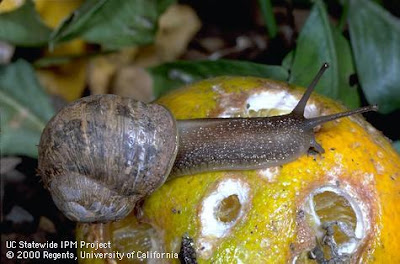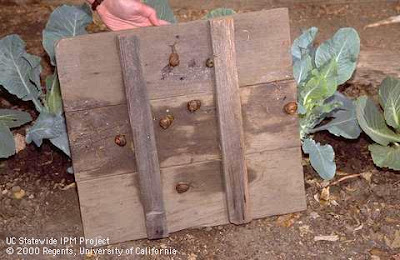
|
|
The brown garden snail (
Cornu aspersum)
is a
voracious garden pest. (Photos courtesy UC IPM)
|
What’s making those holes? Whether or not you see their telltale tracks, don’t count out these usual suspects.
Snails and slugs rank among the most destructive pests in the California garden. They do most of their damage at night. But cool and cloudy days (such as expected later this week) will coax them out during daylight, too.
Why are they so bad? They eat and eat and eat. According to the UC Cooperative Extension master gardeners, these land mollusks prefer succulent foliage or flowers, which is why snails and slugs represent such a threat to tender seedlings. They also like to eat ripe strawberries and tomatoes.
Among their other favorites: Basil, beans, cabbage, dahlia, delphinium, hosta, lettuce, marigolds and many other vegetable plants.
On leaves, their damage is quickly evident. Snails and slugs eat smooth-edged irregular holes and eventually will devour the whole leaf. They travel on a layer of slimy mucus that dries into a silvery trail, a sure sign that a snail or slug has visited. But these are clever little beasts; they can find many hiding places.
The major difference between snails and slugs is the shell. Snails carry a place to retreat and hibernate; slugs do not (and live a much shorter time). Snails take about two years to fully mature; slugs mature in three to six months. Both spend the winter in hiding.
The best way to cut down on snails? Eliminate their hiding places.
“Boards, stones, debris, weedy areas around tree trunks, leafy branches growing close to the ground, and dense ground covers, such as ivy, are ideal sheltering spots,” says the UC’s Integrated Pest Management website.
“Place vegetable gardens or susceptible plants as far away from snail and slug hiding areas as possible,” it added. “Reducing hiding places allows fewer snails and slugs to survive. The survivors congregate in the remaining shelters, where you can more easily locate and remove them.
“Though baits can be part of a management program, it is best to use them in conjunction with habitat modification, especially in gardens that contain plenty of shelter, food, and moisture,” it noted.
Also, some snail baits are poisonous to pets and people.
How do you get snails and slugs to come out of their hiding places? Water around suspected areas in the late afternoon. Return an hour after dark with a flashlight. You’ll see the critters enjoying that ground moisture. (That’s also a good time to pick them up and dispose of these hungry pests. Wear gloves.)
Not all hiding places can be eliminated, note the master gardeners. So, make snail trapping a regular part of your garden routine. Here are the master gardeners’ recommendations:

|
|
Here's an example of a snail trap made of boards.
|
“You can trap snails and slugs beneath boards or flower pots that you position throughout the garden and landscape. Inverted melon rinds also make good traps. Construct wooden traps using 12-by-15-inch boards (or any easy-to-handle size) raised off the ground by 1-inch runners. The runners make it easy for the pests to crawl underneath.
“Scrape off the accumulated snails and slugs daily and destroy them (see hand-picking). Do not use salt to destroy snails and slugs, as it will increase soil salinity.”
What about beer? Is it true snails and slugs can’t resist a stale brew?
“Some people use beer-baited traps buried at ground level to catch and drown slugs and snails that fall into them,” say the master gardeners. “Because it is the fermented part of the product that attracts these pests, you can also use a sugar-water and yeast mixture instead of beer.
“Beer or yeast traps attract slugs and snails within an area of only a few feet, and you must replenish the bait every few days to keep the level deep enough to drown the mollusks. Traps must have deep vertical sides to keep the snails and slugs from crawling out and a top to reduce evaporation. These types of traps are available at garden supply stores, or you can make your own by burying a coffee can, margarine container, or plastic bottle with the top at ground level and placing a lid with holes cut into it over the container.”
For more on snails and slugs:
http://ipm.ucanr.edu/PMG/PESTNOTES/pn7427.html


